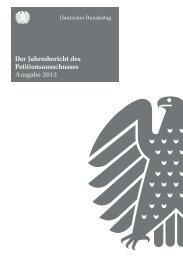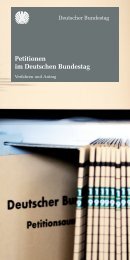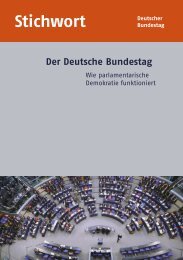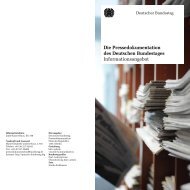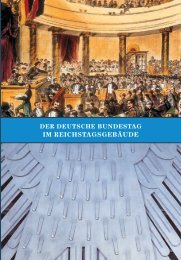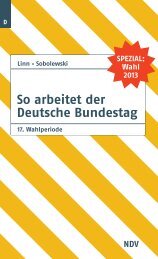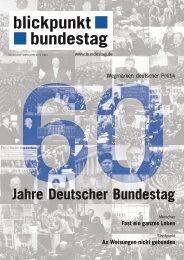Facts - The Bundestag at a glance - Deutscher Bundestag
Facts - The Bundestag at a glance - Deutscher Bundestag
Facts - The Bundestag at a glance - Deutscher Bundestag
You also want an ePaper? Increase the reach of your titles
YUMPU automatically turns print PDFs into web optimized ePapers that Google loves.
<strong>The</strong> Federal Republic is divided into<br />
299 constituencies, from Flensburg in<br />
Schlewig-Holstein, which is Constituency<br />
No 1, to Homburg in the Saarland,<br />
which is numbered 299. Wh<strong>at</strong> determines<br />
the balance of power between<br />
parties in the <strong>Bundestag</strong> is the second<br />
vote. By making this cross on their ballot<br />
papers, voters determine which party<br />
or coalition will win a large enough<br />
share of the vote to elect one of its<br />
members to serve as Federal Chancellor.<br />
Every party can campaign for se<strong>at</strong>s<br />
in the <strong>Bundestag</strong> by drawing up Land<br />
lists of candid<strong>at</strong>es. <strong>The</strong> party submits<br />
such a list in one or more federal st<strong>at</strong>es,<br />
listing in sequence the candid<strong>at</strong>es it<br />
deems suitable. If a party wins enough<br />
second votes in a given Land to merit<br />
the alloc<strong>at</strong>ion of ten se<strong>at</strong>s and has won<br />
four constituency se<strong>at</strong>s in th<strong>at</strong> Land, the<br />
party’s top six list candid<strong>at</strong>es take the<br />
remaining six se<strong>at</strong>s. Parties campaigning<br />
in an election are subject, however,<br />
to the 5% hurdle, whereby a party must<br />
win <strong>at</strong> least five per cent of the n<strong>at</strong>ional<br />
vote in order to enter the <strong>Bundestag</strong>.<br />
<strong>The</strong>re is one exception: if a party wins <strong>at</strong><br />
least three constituency se<strong>at</strong>s, it enters<br />
Parliament with the number of se<strong>at</strong>s corresponding<br />
to its percentage of second<br />
Palimentary elections<br />
votes even if it falls short of the 5%<br />
threshold. This threshold is designed to<br />
prevent a splintering of the party system<br />
th<strong>at</strong> might weaken Parliament.<br />
In principle, half of the se<strong>at</strong>s in the<br />
<strong>Bundestag</strong> are distributed on the basis<br />
of the Land lists, while the other half<br />
are constituency se<strong>at</strong>s. This, however,<br />
accounts for only 598 of the 622 se<strong>at</strong>s<br />
(<strong>at</strong> the start of the electoral term) in the<br />
17th <strong>Bundestag</strong>. Overhang mand<strong>at</strong>es, as<br />
they are known, were won by the CDU/<br />
CSU in certain Länder and accounted<br />
for the remaining 24 se<strong>at</strong>s. <strong>The</strong> number<br />
has since dropped to 22, following the<br />
resign<strong>at</strong>ion of two CDU/CSU Members<br />
elected in these Länder. An overhang<br />
mand<strong>at</strong>e occurs when the number of<br />
constituency se<strong>at</strong>s won by a party in a<br />
particular Land exceeds the number of<br />
se<strong>at</strong>s to which it would be entitled on<br />
the strength of the second vote. If, for<br />
example, a party wins enough second<br />
votes to merit the alloc<strong>at</strong>ion of 15 se<strong>at</strong>s<br />
but its candid<strong>at</strong>es secure the largest<br />
share of the vote in 17 constituencies,<br />
it obtains 17 parliamentary se<strong>at</strong>s. After<br />
all, each of the 17 candid<strong>at</strong>es has been<br />
directly elected. This situ<strong>at</strong>ion would<br />
cre<strong>at</strong>e two extra se<strong>at</strong>s, or overhang mand<strong>at</strong>es,<br />
in the <strong>Bundestag</strong>.



